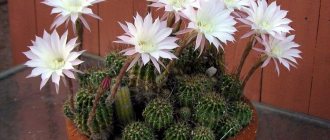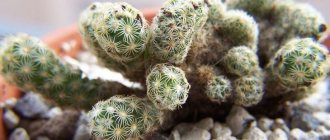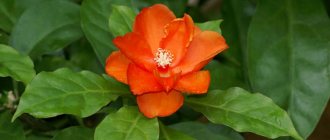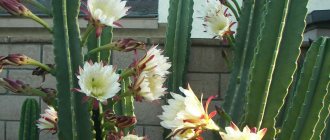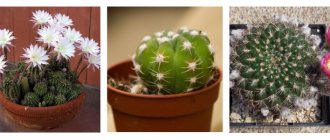Growing and care
The procedure for caring for astrophytums is traditional. The plant requires normal watering, fertilizing, protection from pests and diseases.
Watering
Astrophytum is one of those plants that is better to underwater than overwater. This cactus easily tolerates drought and can survive without water for up to a year. Optimal soil moisture regime:
- in summer - once a week;
- in spring and autumn - once every 15 - 20 days;
- In winter, astrophytum is not watered; you can lightly spray the plant’s needles every 30–40 days.
For irrigation, use settled or filtered water at a temperature of + 20 degrees.
Top dressing
Astrophytum is fertilized only in spring. The number of feedings is no more than 2 - 3, with a break of 25 - 28 days. Feeding rules:
- application after preliminary watering so as not to burn the roots;
- use of complex mixtures for cacti and succulents;
- reduction of the recommended concentration by 2 times.
The last feeding should be done no later than mid-August.
Transfer
Astrophytum does not like transplantation, so it should be done when the stem becomes crowded in the pot. A new container is selected with a diameter 3–4 cm larger than the previous one. When replanting, do not bury the root collar. This will cause the stem to rot.
Wintering
From the end of October to the end of February, the astrophytum is dormant. The optimal conditions for keeping the cactus at this time are temperature from + 5 to + 10 degrees and humidity 50 – 60%. It is impossible to provide such a regime of detention at home.
After wintering, the astrophytum is gradually accustomed to the sun and warmth. If you immediately expose the plant to light in a warm room, there is a risk of burns and stem rotting.
Caring for astrophytum at home
Watering
During the period of active growth, astrophytum needs to be watered regularly and moderately. Between procedures, maintain such a gap so that the earthen lump dries out almost completely. Use softened water (rain, melt, filtered or from the tap, but left standing for at least a day). Make sure that the liquid does not stagnate at the base of the stem. Overmoistening causes the development of mold and rot. In autumn, minimize watering until the soil is moistened monthly; in winter, leave the soil completely dry.
Air humidity
Dry air is not a problem, because the cactus is by nature adapted to such conditions. During a cool winter, the room should not be damp, otherwise the stem will suffer from rot.
Feeding
During the growing season (April-September), it is necessary to feed the plant once a month. Purchase a universal fertilizer for succulents and cacti at a flower shop and apply half the dose indicated on the package.
Reproduction
Astrophytum seedlings @rosi.paolo, Flickr
Astrophytum practically does not form lateral shoots - children, so the seed method is used for propagation. Sowing is carried out at the end of February or the first ten days of March.
The optimal container for the procedure is a seedling greenhouse with a transparent lid. For germination, you need to provide a temperature of + 21..26 degrees. The first shoots appear after 10 – 15 days.
In the first 12 months, about 4 picking procedures are performed. After a year, their number is halved. When the diameter of the cactus reaches 20 mm, it should be transplanted into a separate container. Flowering of young astrophytums occurs after 4 – 6 years.
Picking seedlings of Astrophytum asterias f. Miracle kabuto @sunbird_cactus, Instagram
Types of astrophytum with photos and names
Wild cacti of this genus are considered more capricious than varieties intended for home cultivation. That is why hybrids of this plant or cacti grafted onto Echinopsis are usually used for floriculture. The following types of astrophytum usually become the basis for home varieties:
Astrophytum capricorne
An elegant astrophytum, the height of which in ideal conditions can reach about 30 cm with a diameter of up to 17 cm. In the first years of life, Astrophytum capricorne has a spherical shape, which gradually changes to the shape of an ellipse. Typically, such plants have eight ribs, but their number can vary. The trunk itself is painted green, but on the surface of such a cactus there are many light specks that almost completely hide its main color.
In the upper part of the ribs of the capricorn species there are pubescent areoles. Each of them grows about 6-7 long twisted needles up to 10 cm in size. It is because of their bizarre shape that the plant was given its name. In adult cacti, such needles almost completely cover the trunk.
This species blooms at the beginning of summer. The buds form at the very top of the cactus stem. The color of their petals can be light or bright yellow, and their length reaches 6 cm.
Astrophytum myriostigma or speckled (Astrophytum myriostigma)
Thornless appearance. The smooth trunk of Astrophytum myriostigma is covered with spots that are velvety to the touch. Typically, such cacti have 5 pronounced ribs. They have fluffy areolas. The size of the trunk of an adult plant reaches 25 cm in diameter. Because of its shape, this type is also called the Bishop's miter.
During the flowering period in summer, bright yellow flowers form on the cactus. Their petals are pointed at the top and decorated with a brownish border. In the center of the flower there are noticeable stamens and a rounded pistil. Each flower stays on the plant for about 2-4 days. After the fruits ripen, the seed boxes open in the form of stars, adding decorativeness to the cactus. This species is particularly unpretentious, and also has a number of varieties without a speckled pattern.
Astrophytum asterias
A Mexican species that lives in the north of the country. Astrophytum asterias does not have a fast pace of development. It has a spherical, slightly flattened trunk of a brownish-green color. The trunk is divided into 6-8 inconspicuous ribs, giving the plant a resemblance to a round green pumpkin. In their middle part there are rounded areolas of regular shape, surrounded by light specks. Long, sharp, brown needles grow from them.
During summer flowering, buds form on the areoles. The size of yellowish flowers with a red center reaches 7 cm in diameter. You can admire the flowers of such a cactus only during the daytime. Based on this species, many different varieties have been obtained.
Astrophytum coahuilense
This plant is considered a subspecies of speckled. This cactus can reach impressive sizes compared to its relatives. In suitable conditions, it can develop to a height of one meter with a diameter of about 25 cm. At a young age, Astrophytum coahuilense has clearly defined ribs, but as it grows, its trunk flattens out. It has a bright green color and is complemented by numerous gray dots. This species does not form needles, and its areoles become noticeable only during flowering. The petals of the flowers of this cactus are lemon-colored, and their centers are red-orange.
Decorated astrophytum or ornatum (Astrophytum ornatum)
An unpretentious plant, capable of growing up to 30-40 cm in pots. Astrophytum ornatum has a dark green trunk, with light spots on which are arranged in even stripes. Most of these speckles are concentrated on the ribs, creating patterns of short, plush fibers there. The tufts of needles located on the areolas are light brown in color.
Such a plant begins to bloom only in the 6th year of cultivation, reaching a height of 15 cm. The size and color of flowers in different varieties may vary, but most often there are cacti with yellowish flowers.
Astrophytum Kabuto, or Super Kabuto (Astrophytum Kabuto)
This species includes a group of randomly obtained hybrids of the star-shaped species with other astrophytums. The Japanese breeder Takeo purchased a mother cactus with an unusual pattern of specks in America, and after flowering he collected seeds from it. Approximately 30% of the resulting seedlings were able to retain the characteristics of the main plant. Further work on young cacti made it possible to obtain a number of resistant hybrid varieties. The seeds of Astrophytum Kabuto hybrids no longer convey the properties of the original cactus. Popular varieties of such plants include:
- White snow - with a trunk covered with numerous white specks;
- Tiger (or Zebra) - with stripes on the trunk.
Diseases and pests
If maintenance standards and care rules are violated, astrophytum can be affected by fungus or root rot.
The most common pests of the species:
- scale insect;
- mealybug
- root mealybug
If signs of infection appear, the cactus is washed with soapy water and then treated with Actellik. Replanting into new soil and washing the roots with an insecticide will help prevent rootworms.
Description and origin
The homeland of the cactus is the desert arid territories of Africa and Mexico. The flower first appeared in Europe in the 18th century, thanks to the Belgian explorer Henri-Guillaume Galeotti. In 1839, Charles Lamer introduced the name "Astrophytum" as a whole separate genus. Nowadays, these cacti are often grown as a houseplant. They are distinguished by unpretentious care, slow growth, and attractive exotic appearance. They are characterized by a spherical shape with vertical grooves. Some species have spines, most do not. "Astrophytum" blooms in spring and summer.
Possible problems
When growing astrophytum, the following problems may occur:
| Problem | Possible causes and solution |
| Stretching the stem | Too nutritious soil and excessive watering or lack of lighting. Plants need to be transplanted into a low-nutrient and maximally porous substrate. The pot must have a drain (tray) or 2-3 cm of pebbles at the bottom. Avoid overwatering. |
| Lack of flowering in adulthood | Wrong wintering. To lay flower buds, astrophytum needs to be kept during the dormant period at a temperature of no more than + 12 degrees. |
| Stem deformation | Lack of light or high temperatures in winter. You need to adjust the location and temperature. A severely deformed stem cannot be corrected. |
| Softening the base | Overmoistening of the soil. In the early stages of the development of the problem, replanting into new soil and lack of watering helps. A severely rotten stem cannot be saved. |
| Red spots on the surface | Rotting under the influence of moisture and too low a temperature. Damaged areas of the plant are cut off and sprinkled with charcoal. Such a plant cannot be restored to its former beauty, so it is worth growing a new specimen. |
| Corky spots on the surface of the stem | Pest infestation, injury or hypothermia. The cause may also be insufficient watering in summer or watering with lime water. |
Difficulties in growing astrophytum cactus
Echinopsis cactus: examples of plant care and its varieties
Despite the fact that it is quite easy to maintain a cactus, there are still some problems with improper care:
- Brown spots. This indicates either that the cactus is not watered enough, or that lime water was used.
- Lack of growth. The cactus stops growing either when there is not enough water, or when, on the contrary, there is too much moisture in winter.
Overmoistened astrophytum - Rot at the roots. This is a sign of waterlogged soil.
Kinds
Astrophytum Asterias (Stellate)
Astrophytum Myriostigma (Speckled)
Bibliography:
- Cacti and succulents: Illustrated Encyclopedia / Anderson M. - M.: Niola 21st century, 2002, - 264 pp.: ill.
- Thorn: how to create a green oasis at home. Amazing cacti and succulents / Zhinel Leon. — M.: Eksmo, 2022.— 224 p.: ill.
- Special issue of the newspaper “My Favorite Flowers” No. 11, 2013
3. Varieties of astrophytum:
3.1.Astrophytum myriostigma
Single-growing cacti with spherical green stems covered with silver specks. Often with age, the stems take on a cylindrical shape. Ribs from 3 to 5 - they are vertical or slightly twisted, widely spaced and well defined. There are no spines. The flowers are yellow, funnel-shaped, and appear at the top of the stem.
↑ Up,
3.2. Decorated astrophytum or ornatum - Astrophytum ornatum
Very variable in appearance - the stems can have a different number of ribs and vary in shade from plant to plant - some are green, while others are densely covered with light specks. The fastest growing of the astrophytums. The spines are strong, short, straight, sparse. The flowers are lemon yellow, 7–12 cm in diameter.
↑ Up,


